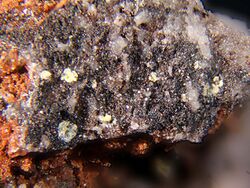Chemistry:Russellite
| Russellite | |
|---|---|
 Yellow globular aggregates of the rare tungsten mineral russellite from the famous Clara Mine (Wolfach, Black Forest, Baden-Württemberg, Germany ). | |
| General | |
| Category | Tungstate minerals |
| Formula (repeating unit) | Bi2WO6 |
| Strunz classification | 4.DE.15 |
| Crystal system | Orthorhombic |
| Crystal class | Pyramidal (mm2) H-M symbol: (mm2) |
| Space group | Pca21 |
| Unit cell | a = 5.43 Å, b = 16.43 Å c = 5.45 Å; Z = 4 |
| Identification | |
| Color | Yellow-green, yellow |
| Crystal habit | Fine-grained, compact, massive |
| Mohs scale hardness | 3.5 |
| Specific gravity | 7.33 - 7.37 |
| Optical properties | Biaxial (+) |
| Refractive index | 2.17 - 2.51 |
| Dispersion | relatively strong |
| References | [1][2][3] |
Russellite is a bismuth tungstate mineral with the chemical formula Bi2WO6.[1] It crystallizes in the orthorhombic crystal system. Russellite is yellow or yellow-green in color, with a Mohs hardness of 3 1⁄2.[1]
Russellite is named for the mineralogist Sir Arthur Russell, and the type locality is the Castle-an-Dinas Mine,[1] near St Columb Major in Cornwall, where it was found in 1938 in wolframite.[4] It occurs as a secondary alteration of other bismuth bearing minerals in tin - tungsten hydrothermal ore deposits, pegmatites and greisens. It typically occurs associated with native bismuth, bismuthinite, bismite, wolframite, ferberite, scheelite, ferritungstite, anthoinite, mpororoite, koechlinite, cassiterite, topaz, muscovite, tourmaline and quartz.[2]
References
- ↑ 1.0 1.1 1.2 1.3 Russellite: Russellite data on Mindat.org
- ↑ 2.0 2.1 Handbook of Mineralogy
- ↑ Webmineral data
- ↑ Embrey, P. G.; Symes, R. F. (1987). "The Mines and Mining". Minerals of Cornwall and Devon. London: British Museum (Natural History). pp. 54. ISBN 0-565-00989-3.

